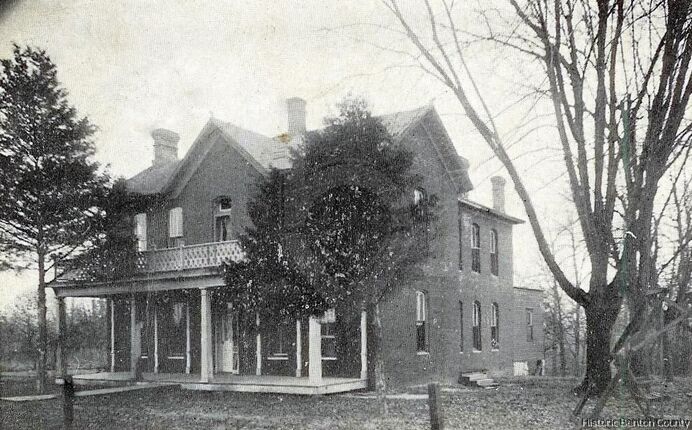Callahan Station - Along the Butterfield Overland Mail Coach Line, located in Rogers
Callahan's Station in Rogers has always been an interesting topic, because it has always held some mystery as to where it was located. Dennis Callahan moved to this area in 1844 and opened an inn for travelers along one of the two main roads that went through Benton County. There was also a well known spring located by the inn called Callahan Springs.
In 1858, the inn came much busier with the coming of the Butterfield Overland Mail Coach Line. The coach ran all the way from St. Louis to San Francisco. It passed through Arkansas on what at that time was called Stage Road, but during the Civil War it was commonly known as Wire Road because of the telegraph line that ran beside it. The stage road in Benton County ran close to where Highway 62 runs north of Rogers today.
Callahan's Station was the first scheduled stop after the stage came into Benton County from the Missouri border. As the stage got close to the station the driver would blow a bugle, so the station was aware of their approach. Most stations along the stage line had had a large stable as to be able to switch out horses and grease the axles of the coach quickly, and a blacksmith shop to do quick repairs and maintenance as needed. While this was all happening a passenger could grab a bite to eat for 40 or 50 cents. After a quick stop the stage would be off to Springdale, by way of Cross Hollows and Mudtown. Then Civil War broke out in 1861 and that was the end of the Butterfield Overland Stage Mail Coach Line, the line only having operated for about four years.
In 1858, the inn came much busier with the coming of the Butterfield Overland Mail Coach Line. The coach ran all the way from St. Louis to San Francisco. It passed through Arkansas on what at that time was called Stage Road, but during the Civil War it was commonly known as Wire Road because of the telegraph line that ran beside it. The stage road in Benton County ran close to where Highway 62 runs north of Rogers today.
Callahan's Station was the first scheduled stop after the stage came into Benton County from the Missouri border. As the stage got close to the station the driver would blow a bugle, so the station was aware of their approach. Most stations along the stage line had had a large stable as to be able to switch out horses and grease the axles of the coach quickly, and a blacksmith shop to do quick repairs and maintenance as needed. While this was all happening a passenger could grab a bite to eat for 40 or 50 cents. After a quick stop the stage would be off to Springdale, by way of Cross Hollows and Mudtown. Then Civil War broke out in 1861 and that was the end of the Butterfield Overland Stage Mail Coach Line, the line only having operated for about four years.
This is a postcard of the Rogers Hospital and Sanitarium taken in about 1910. This is where the Office of Human Concern is now located, at 506 E. Spruce in Rogers, Arkansas.
As to the location of Callahan's Station, there has been some question over time as to exactly where it was located. Some people have said it was located at Electric Springs. This is problematic because the stage line would not be likely to drive out of the way to change out horses, especially when it included an area that would take them up and down some fairly steep terrain. They were looking for a place where they could get things done quickly and get back on the road. Also keep in mind that Callahan's Station existed more than 20 years before Rogers even became a town.
Early documentation supports the thought that the station was located on East Spruce Street, close to where the Office of Human Concern is located now. At least one article says that some portion of that structure may be part of the original Callahan's station. One of the biggest clues as to its location and what became of Callahan Station came from an article in the Atchison Daily Champion dated December 20th, 1881, entitled "Arkansas Springs." The article states, "Beyond the Electric Springs are Mose Springs, the Rock Spring and many others, all beautiful, all pure as a crystal. Rising up to the ridge upon which the railroad runs and upon which Rogers is situated we pass the Callahan Spring famous even before the war; and upon the plateau, now an open common, is to be seen the remains of the old Callahan House, burned by Sigel on his way to the Pea Ridge battlefield."
Early documentation supports the thought that the station was located on East Spruce Street, close to where the Office of Human Concern is located now. At least one article says that some portion of that structure may be part of the original Callahan's station. One of the biggest clues as to its location and what became of Callahan Station came from an article in the Atchison Daily Champion dated December 20th, 1881, entitled "Arkansas Springs." The article states, "Beyond the Electric Springs are Mose Springs, the Rock Spring and many others, all beautiful, all pure as a crystal. Rising up to the ridge upon which the railroad runs and upon which Rogers is situated we pass the Callahan Spring famous even before the war; and upon the plateau, now an open common, is to be seen the remains of the old Callahan House, burned by Sigel on his way to the Pea Ridge battlefield."
A little history on Dennis Callahan: His father was Capt. Dennis Callahan who came from Cork County, Ireland. He served under Washington in the Revolutionary War. His son (also Dennis) was born in Virginia in the late 1700's. He moved to Boone County, Missouri, in the 1820s, then to Washington County by 1835. By 1844, he had settled in Benton County. We know that after the war he continued to live in this county and was buried here in 1879. There are two different spellings found in article with Dennis's last name being spelled either as Callahan or Callaghan.

